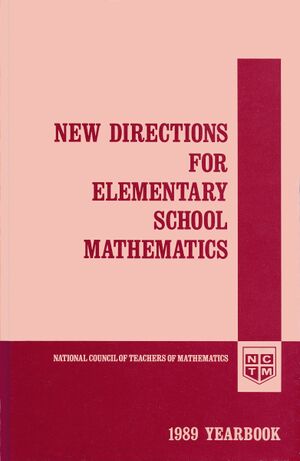New Directions for Elementary School Mathematics (1989 NCTM Yearbook)
Jump to navigation
Jump to search
Contents
Preface
Part 1: Perspective on Change in Elementary School Mathematics
- It's Time to Change by Mary Montgomery Lindquist
- Communication and Reasoning: Critical Dimensions of Sense Making in Mathematics by Glenda Lappan and Pamela W. Schram
- Developing Understanding in Mathematics via Problem Solving by Thomas L. Schroeder and Frank K. Lester, Jr.
- The Role of Computation in the Changing Mathematics Curriculum by Terrence G. Coburn
Part 2: Children's Reasoning and Strategies: Implications for Teaching
- Assessing and Building Thinking Strategies: Necessary Bases for Instruction by Harriett C. Bebout and Thomas P. Carpenter
- Thinking Strategies: Teaching Arithmetic Through Problem Solving by Paul Cobb and Graceann Merkel
Part 3: New Directions in Teaching the Content of the Curriculum
- Language Experiences: A Base for Problem Solving by Rosemary Reuille Irons and Calvin J. Irons
- Using "Part-Whole" Language to Help Children Represent and Solve Word Problems by Edward C. Rathmell and DeAnn M. Huinker
- Making Sense of Numbers by Larry P. Leutzinger and Myrna Bertheau
- Teaching for Understanding: A Focus on Multiplication by Marilyn Burns
- Collecting and Analyzing Real Data in the Elementary School Classroom by Susan Jo Russell and Susan N. Friel
- Developing Measurement Sense by Jean M. Shaw and Mary Jo Puckett Cliatt
- Teaching about Fractions: What, When, and How? by Nadine Bezuk and Kathleen Cramer
- The Calculator as a Tool for Instruction and Learning by Barbara J. Reys
Part 4: In the Classroom
- Making Mathematics Come Alive through a Statistics Project by Alison S. Claus
- The Power of Mathematical Investigations by David J. Whitin
- Hidden Mathematics Lessons by Anita S. VanBrackle
Part 5: Perspectives and New Directions in Teaching and Learning
- Connections Between Psychological Learning Theories and the Elementary Mathematics Curriculum by Diana Lambdin Kroll
- Mathematics Teaching and Learning: Meeting the Needs of Special Learners by Barbara Wilmot and Carol A. Thornton
- Staff Development: Directions and Realities by Arthur A. Hyde
- Cooperative Learning in Mathematics Education by David W. Johnson and Roger T. Johnson
Cite
APA 7
Trafton, P. R. & Shulte, A. P. (Eds.). (1989). New directions for elementary school mathematics. National Council of Teachers of Mathematics.
